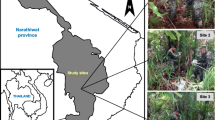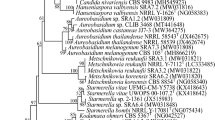Abstract
Seven endophytic yeast strains were isolated from tangerine peel (Citrus reticulata Blanco) and genotyped through clustering with D1/D2 and ITS1-5.8S-ITS2 sequences from GenBank. Phenotypic characteristics were obtained through commercial kits and through assisted species identification. Indole-3-acetic acid (IAA) production by the yeast strains was assessed using Salkowski reagent and High-Performance Liquid chromatography (HPLC). The growth-promoting effects of the yeast were evaluated using the ‘ragdoll’ method. CRYb1, CRYb2 and CRYb7 isolates were identified as the closest species Hanseniaspora opuntiae. CRYb3 was identified as Pichia kluyveri. CRYb4, CRYb5 and CRYb6 were identified as Meyerozyma guilliermondii. CRYb1, CRYb5, CRYb6 and CRYb7 were found to be capable of IAA production. The most promising yeast strains now require further evaluation for their ability to promote plant growth in vitro and in vivo. These data increase our knowledge of the distribution and biological properties of endophytic yeast. This is important information that will be required to fully harness the growth-promoting properties of yeast strains.



Similar content being viewed by others
References
Petrini O (1991) Fungal endophytes of tree leaves. In: Andrews I, Hirano SS (eds) Microbial ecology of leaves. Springer, New York, pp 179–197. https://doi.org/10.1007/978-1-4612-3168-4_9
Hallmann J, Quadt-Hallmann A, Rodrı́Guez-Kábana R, Kloepper JW (1998) Interactions between meloidogyne incognita and endophytic bacteria in cotton and cucumber. Soil Biol Biochem 30(7):925–937. https://doi.org/10.1016/S0038-0717(97)00183-1
Lacava PT, Li W, Araújo WL, Azevedo JL, Hartung JS (2007) The endophyte Curtobacterium flaccumfaciens reduces symptoms caused by Xylella fastidiosa in Catharanthus roseus. J Microbiol 45(5):388–393. https://doi.org/10.1016/j.mimet.2007.08.002
Pirttilä AM, Pospiech H, Laukkanen H, Myllylä R, Hohtola A (2003) Two endophytic fungi in different tissues of scots pine buds (Pinus sylvestris L.). Microb Ecol 45(1):53–62. https://doi.org/10.1007/s00248-002-1038-8
Doty SL (2013) Endophytic yeasts: biology and applications. In: Aroca R (ed) Symbiotic Endophytes. Springer, Berlin, pp 335–343. https://doi.org/10.1007/978-3-642-39317-4_17
Sadeghi F, Samsampour D, Seyahooei MA, Bagheri A, Soltani J (2019) Diversity and spatiotemporal distribution of fungal endophytes associated with citrus reticulata cv. siyahoo. Curr Microbiol 76(3):279–289. https://doi.org/10.1007/s00284-019-01632-9
Camatti-Sartori V, da Silva-Ribeiro RT, Valdebenito-Sanhueza RM, Pagnocca FC, Echeverrigaray S, Azevedo JL (2005) Endophytic yeasts and filamentous fungi associated with southern Brazilian apple (Malus domestica) orchards subjected to conventional, integrated or organic cultivation. J Basic Microbiol 45(5):397–402. https://doi.org/10.1002/jobm.200410547
Nassar AH, El-Tarabily KA, Sivasithamparam K (2005) Promotion of plant growth by an auxin-producing isolate of the yeastwilliopsis saturnusendophytic in maize (zea maysl) roots. Biol Fertil Soils 42(2):97–108. https://doi.org/10.1007/s00374-005-0008-y
Kurtzman CP, Robnett CJ (1998) Identification and phylogeny of ascomycetous yeasts from analysis of nuclear large subunit (26S) ribosomal DNA partial sequences. Antonie Van Leeuwenhoek 73(4):331–371. https://doi.org/10.1023/A:1001761008817
Schloss PD, Westcott SL (2011) Assessing and improving methods used in operational taxonomic unit-based approaches for 16S rRNA gene sequence analysis. Appl Environ Microbiol 77(10):3219. https://doi.org/10.1128/AEM.02810-10
Xin G, Glawe D, Doty SL (2009) Characterization of three endophytic, indole-3-acetic acid-producing yeasts occurring in populus trees. Mycol Res 113(9):973–980. https://doi.org/10.1016/j.mycres.2009.06.001
Khan Z, Guelich G, Phan H, Redman R, Doty S (2012) Bacterial and yeast endophytes from poplar and willow promote growth in crop plants and grasses. ISRN Agronomy. 2012. https://doi.org/10.5402/2012/890280
Andrea F, Robert O, Asaf S, Jeremy S, Zareen K, Redman RS, Fleck ND, Erika L, Grigoriev IV, Doty SL (2015) Genome sequence of the plant growth promoting endophytic yeast Rhodotorula graminis WP1. Front Microbiol 6:978. https://doi.org/10.3389/fmicb.2015.00978
Pontecorvo G, Roper JA, Hemmons LM, Macdonald KD, Bufton AW (1953) The genetics of Aspergillus nidulans. Adv Genet 5(2):141–238. https://doi.org/10.1016/S0065-2660(08)60408-3
Kurtzman CP, Fell JW, Boekhout T, Robert V (2011) Chapter 7–methods for isolation, phenotypic characterization and maintenance of yeasts. Yeasts 1(14):87–110
Young TW (1999). The biochemistry and physiology of yeast growth. In Brewing microbiology. Springer, Boston, pp. 13–42. https://doi.org/10.1007/978-1-4684-0038-0_2
Ausubel FM, Baatout S (1996) Short protocols in molecular biology (3rd edn). Trends Genet 12(8):325–325. https://doi.org/10.1002/0471142727
Kurtzman CP, Robnett CJ (1998) Identification and phylogeny of ascomycetous yeasts from analysis of nuclear large subunit (26S) ribosomal DNA partial sequences. Antonie Van Leeuwenhoek 73(4):331–371. https://doi.org/10.1023/A:1001761008817
White TJ, Bruns T, Lee SJWT, Taylor JL (1990) Amplification and direct sequencing of fungal ribosomal RNA genes for phylogenetics. PCR Protocols 18(1):315–322. https://doi.org/10.1016/B978-0-12-372180-8.50042-1
Kimura M (1980) A simple method for estimating evolutionary rates of base substitutions through comparative studies of nucleotide sequences. J Mol Evol 16(2):111–120. https://doi.org/10.1007/bf01731581
Saitou N, Nei M (1987) The neighbor-joining method: a new method for reconstructing phylogenetic trees. Mol Biol Evol 4(4):406. https://doi.org/10.1093/oxfordjournals.molbev.a040454
Felsenstein J (1985) Confidence limits on phylogenies: an approach using the bootstrap. Evolution 39(4):783–791. https://doi.org/10.1111/j.1558-5646.1985.tb00420.x
Gordon SA, Weber RP (1951) Colorimetric estimation of indoleacetic acid. Plant Physiol 26:192–195. https://doi.org/10.1104/pp.26.1.192
Sarwar A, Latif Z, Zhang S, Zhu J, Zechel DL, Bechthold A (2018) Biological control of potato common scab with rare Isatropolone C compound produced by plant growth promoting Streptomyces A1RT. Front Microbiol 9:1126. https://doi.org/10.3389/fmicb.2018.01126
Chamblee DS, Green JT (1995) Production and utilization of pastures and forages in North Carolina. Technical Bulletin, USA
Sugita T, Nishikawa A (2003) Fungal identification method based on DNA sequence analysis: reassessment of the methods of the Pharmaceutical Society of Japan and the Japanese Pharmacopoeia. J Health Sci 49(6):531–533. https://doi.org/10.1248/jhs.49.531
Ruiz-Moyano S, Martín A, Villalobos MC, Calle A, Serradilla MJ, Córdoba M, Hernández A (2016) Yeasts isolated from figs (Ficus carica L.) as biocontrol agents of postharvest fruit diseases. Food Microbiol 57:45–53. https://doi.org/10.1016/j.fm.2016.01.003
Hyun SH, Lee JG, Park WJ, Kim HK, Lee JS (2014) Isolation and diversity of yeasts from fruits and flowers of orchard in Sinam-myeon of Yesan-gun, Chungcheongnam-do Korea. Korean J Mycol 42(1):21–27. https://doi.org/10.4489/KJM.2014.42.1.21
Liu R, Zhang Q, Chen F, Zhang X (2015) Analysis of culturable yeast diversity in spontaneously fermented orange wine, orange peel and orangery soil of a Ponkan plantation in China. Ann Microbiol 65(4):2387–2391. https://doi.org/10.1007/s13213-015-1081-6
Ren F, Dong W, Sun H, Yan DH (2019) Endophytic mycobiota of jingbai pear trees in north China. Forests 10(3):260. https://doi.org/10.3390/f10030260
Rana KL, Kour D, Sheikh I, Dhiman A, Yadav N, Yadav AN, Singh K, Saxena, AK (2019). Endophytic fungi: biodiversity, ecological significance, and potential industrial applications. In Recent Advancement in White Biotechnology Through Fungi. Springer, Cham, pp. 1–62. https://doi.org/10.1007/978-3-030-10480-1_1
de Souza Varize C, Christofoleti-Furlan RM, Muynarsk EDSM, de Melo Pereira GV, Lopes LD, Basso LC (2019). Biotechnological applications of nonconventional yeasts. In Yeasts in Biotechnology. IntechOpen. https://doi.org/10.5772/intechopen.83035
Mannazzu I, Domizio P, Carboni G, Zara S, Zara G, Comitini F, Budroni M, Ciani M (2019) Yeast killer toxins: from ecological significance to application. Crit Rev Biotechnol 39:1–15. https://doi.org/10.1080/07388551.2019.1601679
Gai CS, Lacava PT, Maccheroni W Jr, Glienke C, Araújo WL, Miller TA, Azevedo JL (2009) Diversity of endophytic yeasts from sweet orange and their localization by scanning electron microscopy. J Basic Microbiol 49(5):441–451. https://doi.org/10.1002/jobm.200800328
Paul LK, Khurana JP (2008) Phytochrome-mediated light signaling in plants: emerging trends. Physiol Mol Biol Plants 14(1–2):9–22. https://doi.org/10.1007/s12298-008-0002-6
Hrazdina G, Jensen RA (1992) Spatial organization of enzymes in plant metabolic pathways. Annu Rev Plant Physiol Plant Mol Biol 43(1):241–267
Radwanski ER, Last RL (1995) Tryptophan biosynthesis and molecular genetics biochemical and molecular genetics. Plant Cell 7(7):921–934. https://doi.org/10.2307/3870047
Mehmood A, Khan N, Irshad M, Hamayun M (2018) IAA producing endopytic fungus fusariun oxysporum wlw colonize maize roots and promoted maize growth under hydroponic condition. Eur Exp Biol 8(4):24. https://doi.org/10.21767/2248-9215.100065
Isaeva OV, Glushakova AM, Garbuz SA, Kachalkin AV, Iiu C (2010) Endophytic yeast fungi in plant storage tissues. Biol Bull 37(1):26–34. https://doi.org/10.1134/S1062359010010048
Acknowledgements
This work was supported in part by Lanzhou Science and Technology Plan Project 2018-1-104; Northwest Normal University Innovation Capacity Improvement Program CXCY2018B009; Gansu International Science and Technology Cooperation Special 1504WKCA028.
Funding
This study was funded by Lanzhou Science and Technology Plan Project (2018-1-104); Northwest Normal University Innovation Capacity Improvement Program (Grant No. CXCY2018B009); Gansu International Science and Technology Cooperation Special (Grant No. 1504WKCA028).
Author information
Authors and Affiliations
Corresponding author
Ethics declarations
Conflict of interest
The authors declare that they have no conflict of interest.
Research Involving Human Participants and/or Animals
This article does not contain any studies with human participants or animals performed by any of the authors.
Informed Consent
Informed consent was obtained from all individual participants included in the study.
Additional information
Publisher's Note
Springer Nature remains neutral with regard to jurisdictional claims in published maps and institutional affiliations.
Electronic supplementary material
Below is the link to the electronic supplementary material.
Rights and permissions
About this article
Cite this article
Ling, L., Li, Z., Jiao, Z. et al. Identification of Novel Endophytic Yeast Strains from Tangerine Peel. Curr Microbiol 76, 1066–1072 (2019). https://doi.org/10.1007/s00284-019-01721-9
Received:
Accepted:
Published:
Issue Date:
DOI: https://doi.org/10.1007/s00284-019-01721-9




